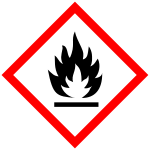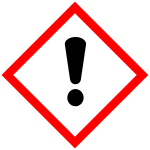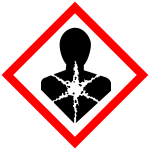
聯(lián) 系 人:
朱先生
手 機(jī): 13914990770
傳 真:0512-57482091
地 址:昆山市淀山湖鎮(zhèn)曙光路19-28號(hào)
網(wǎng) 址:http://minlohg.cn
According to the UN GHS revision 9
Toluene - methylbenzol; Benzene, methyl-; Toluene Kun shan minglong 13914990770 Monday to Friday, 9am-5pm (Standard time zone: UTC/GMT +8 hours). Flammable liquids, Category 2 Skin irritation, Category 2 Aspiration hazard, Category 1 Specific target organ toxicity – single exposure, Category 3 Specific target organ toxicity – repeated exposure, Category 2 Reproductive toxicity, Category 2 Danger H225 Highly flammable liquid and vapour H315 Causes skin irritation H304 May be fatal if swallowed and enters airways H336 May cause drowsiness or dizziness H373 May cause damage to organs through prolonged or repeated exposure P210 Keep away from heat, hot surfaces, sparks, open flames and other ignition sources. No smoking. P233 Keep container tightly closed. P240 Ground and bond container and receiving equipment. P241 Use explosion-proof [electrical/ventilating/lighting/...] equipment. P242 Use non-sparking tools. P243 Take action to prevent static discharges. P280 Wear protective gloves/protective clothing/eye protection/face protection/hearing protection/... P264 Wash ... thoroughly after handling. P261 Avoid breathing dust/fume/gas/mist/vapours/spray. P271 Use only outdoors or in a well-ventilated area. P260 Do not breathe dust/fume/gas/mist/vapours/spray. P203 Obtain, read and follow all safety instructions before use. P303+P361+P353 IF ON SKIN (or hair): Take off immediately all contaminated clothing. Rinse affected areas with water [or shower]. P370+P378 In case of fire: Use ... to extinguish. P302+P352 IF ON SKIN: Wash with plenty of water/... P321 Specific treatment (see ... on this label). P332+P317 If skin irritation occurs: Get medical help. P362+P364 Take off contaminated clothing and wash it before reuse. P301+P316 IF SWALLOWED: Get emergency medical help immediately. P331 Do NOT induce vomiting. P304+P340 IF INHALED: Remove person to fresh air and keep comfortable for breathing. P319 Get medical help if you feel unwell. P318 IF exposed or concerned, get medical advice. P403+P235 Store in a well-ventilated place. Keep cool. P405 Store locked up. P403+P233 Store in a well-ventilated place. Keep container tightly closed. P501 Dispose of contents/container to an appropriate treatment and disposal facility in accordance with applicable laws and regulations, and product characteristics at time of disposal. no data available Fresh air, rest. Refer for medical attention. Remove contaminated clothes. Rinse and then wash skin with water and soap. Refer for medical attention . First rinse with plenty of water for several minutes (remove contact lenses if easily possible), then refer for medical attention. Rinse mouth. Do NOT induce vomiting. Refer for medical attention . no data available no data available Use dry chemical, carbon dioxide or alcohol-resistant foam. Highly flammable. Vapour/air mixtures are explosive. Use powder, AFFF, foam, carbon dioxide. In case of fire: keep drums, etc., cool by spraying with water. Evacuate danger area! Consult an expert! Personal protection: chemical protection suit and self-contained breathing apparatus. Ventilation. Remove all ignition sources. Do NOT wash away into sewer. Do NOT let this chemical enter the environment. Collect leaking and spilled liquid in sealable containers as far as possible. Absorb remaining liquid in sand or inert absorbent. Then store and dispose of according to local regulations. Prevent further spillage or leakage if it is safe to do so. Do not let the chemical enter drains. Discharge into the environment must be avoided. Collect and arrange disposal. Keep the chemical in suitable and closed containers for disposal. Remove all sources of ignition. Use spark-proof tools and explosion-proof equipment. Adhered or collected material should be promptly disposed of, in accordance with appropriate laws and regulations. NO open flames, NO sparks and NO smoking. Closed system, ventilation, explosion-proof electrical equipment and lighting. Prevent build-up of electrostatic charges (e.g., by grounding). Do NOT use compressed air for filling, discharging, or handling. Use non-sparking handtools. Handling in a well ventilated place. Wear suitable protective clothing. Avoid contact with skin and eyes. Avoid formation of dust and aerosols. Use non-sparking tools. Prevent fire caused by electrostatic discharge steam. Fireproof. Separated from strong oxidants. TLV: 20 ppm as TWA; A4 (not classifiable as a human carcinogen); BEI issued.MAK: 190 mg/m3, 50 ppm; peak limitation category: II(4); skin absorption (H); pregnancy risk group: C.EU-OEL: 192 mg/m3, 50 ppm as TWA; 384 mg/m3, 100 ppm as STEL; (skin) no data available Ensure adequate ventilation. Handle in accordance with good industrial hygiene and safety practice. Set up emergency exits and the risk-elimination area. Wear safety goggles. Protective gloves. Use ventilation, local exhaust or breathing protection. no data available Colorless liquid no data available no data available -95 °C 110-111°C(lit.) no data available no data available 4°C 997°F no data available no data available no data available In water: 0.5 g/L (20 °C) 2.69 22 mm Hg ( 20 °C) 0.865g/mLat 25°C(lit.) 3.2 (vs air) no data available no data available no data available The vapour mixes well with air, explosive mixtures are easily formed. As a result of flow, agitation, etc., electrostatic charges can be generated.Reacts violently with strong oxidants. This generates fire and explosion hazard. no data available no data available no data available Oral: no data available Inhalation: no data available Dermal: no data available no data available no data available no data available no data available no data available no data available The substance is irritating to the eyes and respiratory tract. The substance may cause effects on the central nervous system. If this liquid is swallowed, aspiration into the lungs may result in chemical pneumonitis. Exposure at high levels could cause cardiac dysrhythmia and unconsciousness. The substance defats the skin, which may cause dryness or cracking. The substance may have effects on the central nervous system. Exposure to the substance may increase noise-induced hearing loss. Animal tests show that this substance possibly causes toxicity to human reproduction or development. A harmful contamination of the air can be reached rather quickly on evaporation of this substance at 20°C. Toxicity to fish: no data available Toxicity to daphnia and other aquatic invertebrates: no data available Toxicity to algae: no data available Toxicity to microorganisms: no data available no data available no data available no data available no data available The material can be disposed of by removal to a licensed chemical destruction plant or by controlled incineration with flue gas scrubbing. Do not contaminate water, foodstuffs, feed or seed by storage or disposal. Do not discharge to sewer systems. Containers can be triply rinsed (or equivalent) and offered for recycling or reconditioning. Alternatively, the packaging can be punctured to make it unusable for other purposes and then be disposed of in a sanitary landfill. Controlled incineration with flue gas scrubbing is possible for combustible packaging materials. no data available no data available CAS: Chemical Abstracts Service ADR: European Agreement concerning the International Carriage of Dangerous Goods by Road RID: Regulation concerning the International Carriage of Dangerous Goods by Rail IMDG: International Maritime Dangerous Goods IATA: International Air Transportation Association TWA: Time Weighted Average STEL: Short term exposure limit LC50: Lethal Concentration 50% LD50: Lethal Dose 50% EC50: Effective Concentration 50% IPCS - The International Chemical Safety Cards (ICSC), website: http://www.ilo.org/dyn/icsc/showcard.home HSDB - Hazardous Substances Data Bank, website: https://toxnet.nlm.nih.gov/newtoxnet/hsdb.htm IARC - International Agency for Research on Cancer, website: http://www.iarc.fr/ eChemPortal - The Global Portal to Information on Chemical Substances by OECD, website: http://www.echemportal.org/echemportal/index?pageID=0&request_locale=en CAMEO Chemicals, website: http://cameochemicals.noaa.gov/search/simple ChemIDplus, website: http://chem.sis.nlm.nih.gov/chemidplus/chemidlite.jsp ERG - Emergency Response Guidebook by U.S. Department of Transportation, website: http://www.phmsa.dot.gov/hazmat/library/erg Germany GESTIS-database on hazard substance, website: http://www.dguv.de/ifa/gestis/gestis-stoffdatenbank/index-2.jsp ECHA - European Chemicals Agency, website: https://echa.europa.eu/SECTION 1: Identification
1.1GHS Product identifier
Product name 1.2Other means of identification
Product number Other names 1.3Recommended use of the chemical and restrictions on use
Identified uses Uses advised against 1.4Supplier's details
Company Address Telephone 1.5Emergency phone number
Emergency phone number Service hours SECTION 2: Hazard identification
2.1Classification of the substance or mixture
2.2GHS label elements, including precautionary statements
Pictogram(s) 


Signal word Hazard statement(s) Precautionary statement(s) Prevention Response Storage Disposal 2.3Other hazards which do not result in classification
SECTION 3: Composition/information on ingredients
3.1Substances
Chemical name Common names and synonyms CAS number EC number Concentration Toluene Toluene 108-88-3 203-625-9 100% SECTION 4: First-aid measures
4.1Description of necessary first-aid measures
If inhaled
Following skin contact
Following eye contact
Following ingestion
4.2Most important symptoms/effects, acute and delayed
4.3Indication of immediate medical attention and special treatment needed, if necessary
SECTION 5: Fire-fighting measures
5.1Suitable extinguishing media
5.2Specific hazards arising from the chemical
5.3Special protective actions for fire-fighters
SECTION 6: Accidental release measures
6.1Personal precautions, protective equipment and emergency procedures
6.2Environmental precautions
6.3Methods and materials for containment and cleaning up
SECTION 7: Handling and storage
7.1Precautions for safe handling
7.2Conditions for safe storage, including any incompatibilities
SECTION 8: Exposure controls/personal protection
8.1Control parameters
Occupational Exposure limit values
Biological limit values
8.2Appropriate engineering controls
8.3Individual protection measures, such as personal protective equipment (PPE)
Eye/face protection
Skin protection
Respiratory protection
Thermal hazards
SECTION 9: Physical and chemical properties and safety characteristics
Physical state Colour Odour Melting point/freezing point Boiling point or initial boiling point and boiling range Flammability Lower and upper explosion limit/flammability limit Flash point Auto-ignition temperature Decomposition temperature pH Kinematic viscosity Solubility Partition coefficient n-octanol/water Vapour pressure Density and/or relative density Relative vapour density Particle characteristics SECTION 10: Stability and reactivity
10.1Reactivity
10.2Chemical stability
10.3Possibility of hazardous reactions
10.4Conditions to avoid
10.5Incompatible materials
10.6Hazardous decomposition products
SECTION 11: Toxicological information
Acute toxicity
Skin corrosion/irritation
Serious eye damage/irritation
Respiratory or skin sensitization
Germ cell mutagenicity
Carcinogenicity
Reproductive toxicity
STOT-single exposure
STOT-repeated exposure
Aspiration hazard
SECTION 12: Ecological information
12.1Toxicity
12.2Persistence and degradability
12.3Bioaccumulative potential
12.4Mobility in soil
12.5Other adverse effects
SECTION 13: Disposal considerations
13.1Disposal methods
Product
Contaminated packaging
SECTION 14: Transport information
14.1UN Number
ADR/RID: UN1294 (For reference only, please check.) IMDG: UN1294 (For reference only, please check.) IATA: UN1294 (For reference only, please check.) 14.2UN Proper Shipping Name
ADR/RID: TOLUENE (For reference only, please check.) IMDG: TOLUENE (For reference only, please check.) IATA: TOLUENE (For reference only, please check.) 14.3Transport hazard class(es)
ADR/RID: 3 (For reference only, please check.) IMDG: 3 (For reference only, please check.) IATA: 3 (For reference only, please check.) 14.4Packing group, if applicable
ADR/RID: II (For reference only, please check.) IMDG: II (For reference only, please check.) IATA: II (For reference only, please check.) 14.5Environmental hazards
ADR/RID: No IMDG: No IATA: No 14.6Special precautions for user
14.7Transport in bulk according to IMO instruments
SECTION 15: Regulatory information
15.1Safety, health and environmental regulations specific for the product in question
Chemical name Common names and synonyms CAS number EC number Toluene Toluene 108-88-3 203-625-9 European Inventory of Existing Commercial Chemical Substances (EINECS) Listed. EC Inventory Listed. United States Toxic Substances Control Act (TSCA) Inventory Listed. China Catalog of Hazardous chemicals 2015 Listed. New Zealand Inventory of Chemicals (NZIoC) Listed. Philippines Inventory of Chemicals and Chemical Substances (PICCS) Listed. Vietnam National Chemical Inventory Listed. Chinese Chemical Inventory of Existing Chemical Substances (China IECSC) Listed. Korea Existing Chemicals List (KECL) Listed. SECTION 16: Other information
Information on revision
Creation Date July 15, 2019 Revision Date July 15, 2019 Abbreviations and acronyms
References